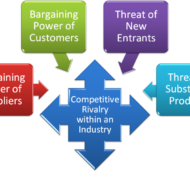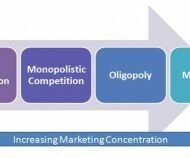Posted by Managementguru in Business Management, Marketing, Organisational behaviour, Principles of Management, Strategy
on Mar 22nd, 2014 | 0 comments

PORTER’S FIVE FORCES Porter’s five forces analysis-draws upon industrial organization (IO) economics to derive five forces that determine the competitive intensity and therefore attractiveness of a market. Survival of the Fittest: True to Darwin’s theory “Survival of the fittest”, only competitive firms survive in the business market, provided, they have made the right strategic choice by comprehensively analyzing their position in the industry. Every organization is part of the industry and almost all of them face competition. Thus, industry and competition are the vital considerations for making a strategic choice. All the firms in a particular industry vie for the same set of customers by offering identical or similar products with minor variations. The analysis of the external environment in relation to the context of industry attractiveness thus becomes essential. A Critical Evaluation of Michael Porter’s Five Forces Framework Industrial Analysis: Industry analysis helps a firm to also fix long range plans, by gauging long term growth opportunities present if any. Strategic choice is nothing but, to screen all possible strategic alternatives followed by narrowing down the choice to the best suited and feasible alternatives and ultimately choosing an optimum strategy. To explain it in more clear terms, let us look at this example. Say, if there are three big players of car manufacturers in an automobile industry. Each follows their own strategic style to capture the market. What are the threat factors? Threat can be in the form of four-wheeler manufacturers like trucks and jeeps, but these cannot be competitively priced. Threat can be in the form of suppliers who dominate the industry by having a grip on the supply of components, sub-assemblies and accessories. Threat in the form of new entrants, but the growth might be restricted due to government regulations. A thorough analysis of the automobile industry thus made can make things clear to the firm, as to where they stand in terms of market share, what are their strengths and weaknesses, who pose a threat, what are the potential opportunities for growth and to tap market segments whose needs are unidentified. Still, it will be a seller’s market where the buyers have no bargaining power. On the other hand, if the weather does not favor its growth, the firm has to immediately decide on its next course of action, calling for diversification. The possible threats for a firm can come from five directions as mentioned below: Potential threat from new firms entering the market Threat from substitutes available in the market Threat from competitors Bargaining power of the suppliers Bargaining power of the buyers The structure and dynamics of an industry has to be analyzed in order to determine the intensity of competition and profitability. As the market is very dynamic, it becomes mandatory for firms to evolve strategies embracing a modern approach, with emphasis on reappraisal of existing strategy in the light of changing external conditions and formulation of alternative...

Posted by Managementguru in Business Management, Marketing, Principles of Management
on Mar 4th, 2014 | 0 comments

Market Structure and Pricing Decisions- An overview What is Market Structure: It is the makeup of a particular market like different characteristics, size, value, number of providers etc. Business markets are always dynamic in nature and influenced by the number and size of potential buyers and sellers, which in turn affects the pricing of a product. If the price is set too high, say, in a homogeneous market, the firm will not be able to survive and compete with other suppliers in the market. If the price is too low, it will not be sufficient enough to cover the profit margin. If you are a monopoly player, then you are the price maker and the price you fix goes unchallenged. First let us have a glimpse on different kinds of market structure and their effect on determining the price. Four different market structures are identified. Perfect Competition Consists of huge number of buyers and sellers, each too small to affect the price of the product-sellers are “price takers and not price makers.” Homogenous products Easy entry and exit to and from the market Agents have perfect knowledge about market conditions. Here, the product is totally undifferentiated and the sellers always sell their product at market determined prices. Otherwise, they fail to attract their customers. Price cutting becomes unnecessary as producers can sell their total output at market price. Online Marketing Monopoly Only one seller in the market Factors prevail that stops other firms from entering into the market, such as, exclusive government license, access to natural resources, patent holding, being a pioneer in the field etc., The product is highly differentiated from other goods There must be no good substitutes Monopolistic Competition Has elements of both monopoly and perfect competition Resembles monopoly in that, product of individual firms are slightly differentiated from others and does not serve as a perfect substitute Resembles perfect competition, in the sense that, there are a large number of sellers and the action of one does not have any effect on the other The difference lies in the fact that sellers have some control over price fixing as some customers might be willing to pay a slightly higher price if the products are differentiated from the competitors. Oligopoly Involves unspecified number of buyers Only a small number of sellers exist The actions of each firm affect the other sellers in an oligopoly market Products are homogenous or differentiated To persist in the long run an oligopoly firm has to do something that prevents the entry of new firms into the market, either in the form of product differentiation or clever advertising. Price cutting or increase affects the sales of other firms too and so the sellers must be cautious of this interdependent characteristic of the market structure. Social Media Marketing A clear idea and analysis of the market structure in which the firm operates, target customers, size of the firm and knowledge about competitor strategy as well as general trend of the market is helpful in formulating appropriate strategies regarding pricing and promotion of your...




